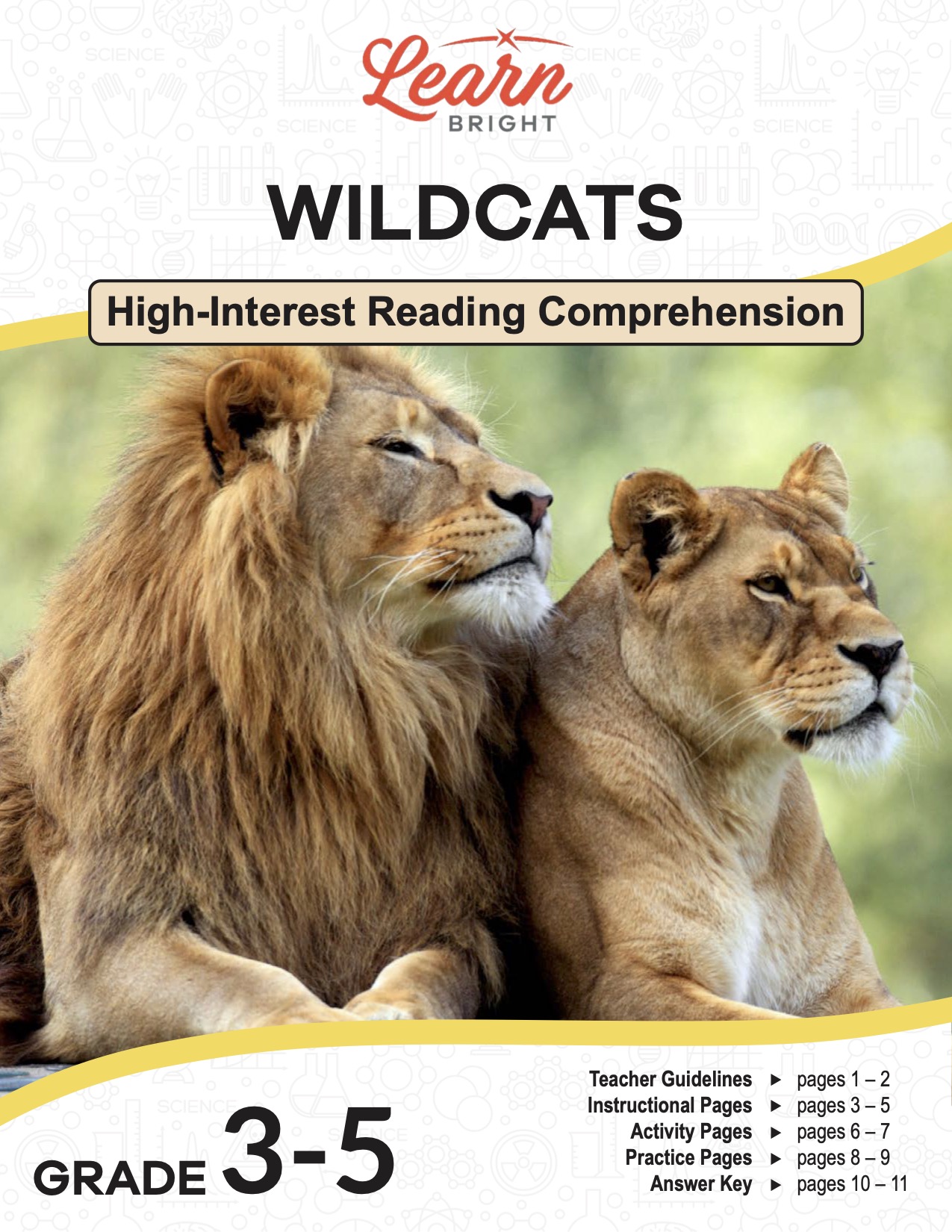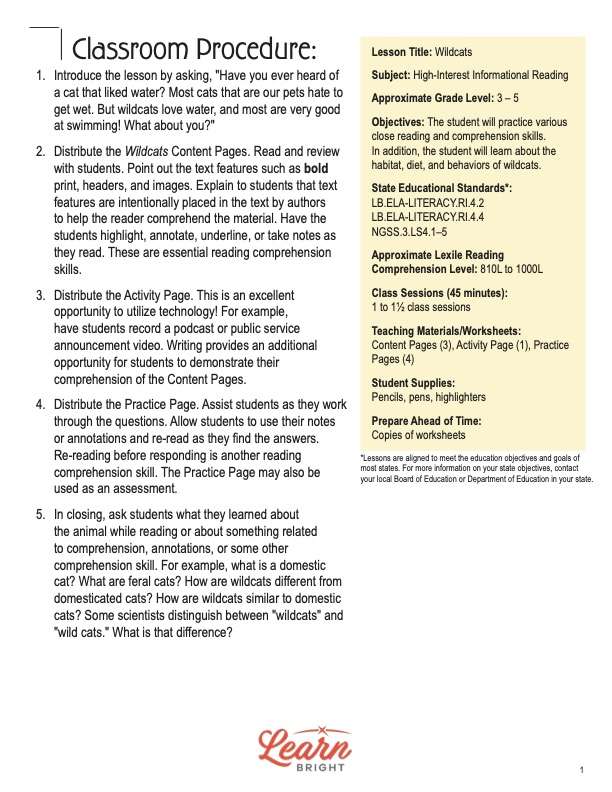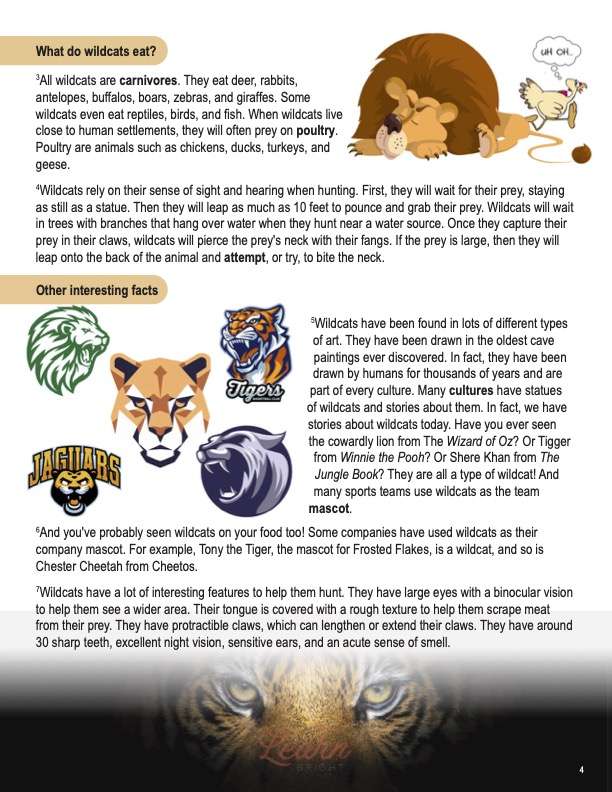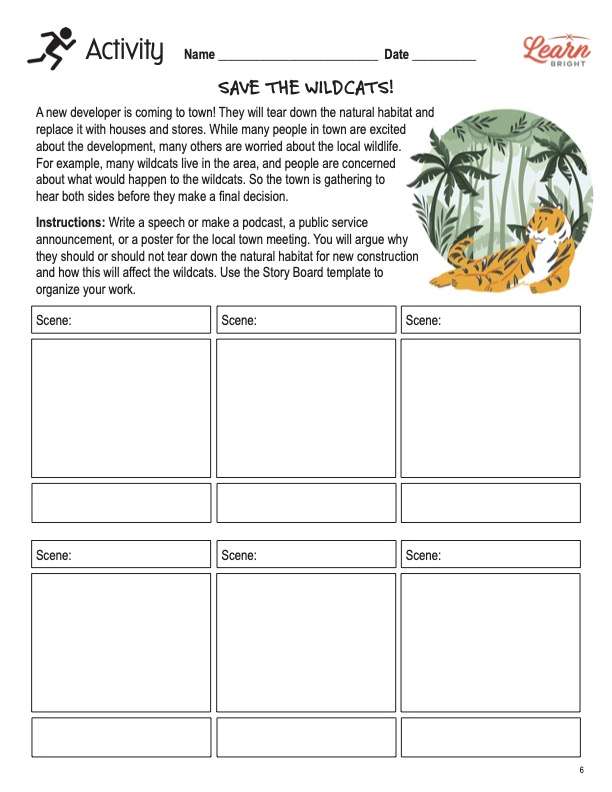Description
What our Wildcats lesson plan includes
Lesson Objectives and Overview: Wildcats is a high-interest reading comprehension lesson plan. As such, students will practice various close reading and comprehension skills. In addition, they will learn about the habitat, diet, and behaviors of wildcats in general. This lesson is for students in 3rd grade, 4th grade, and 5th grade.
Classroom Procedure
Every lesson plan provides you with a classroom procedure page that outlines a step-by-step guide to follow. You do not have to follow the guide exactly. The guide helps you organize the lesson and details when to hand out worksheets. It also lists information in the yellow box that you might find useful. You will find the lesson objectives, state standards, and number of class sessions the lesson should take to complete in this area. In addition, it describes the supplies you will need as well as what and how you need to prepare beforehand.
Teacher Notes
The paragraph on this page gives you a little more information on the lesson overall and describes what you may want to focus your teaching on. It explains that you can teach this lesson in a whole-class setting or as an independent, small-group activity. The blank lines are available for you to write out any thoughts or ideas you have as you prepare.
WILDCATS LESSON PLAN CONTENT PAGES
What Are Wildcats?
The Wildcats lesson plan contains three content pages. It begins by providing a box of background information about this group of cats. These mammals are carnivores that live anywhere from 10 to 15 years. You can find wildcats on almost every continent except for Australia and Antarctica. The lesson then provides a paragraph of information that distinguishes wildcats from domesticated and feral cats.
Wildcats live all over the world in many different habitats. They all have a common ancestor that lived in Asia about 10 million years ago. Over time, they migrated to other parts of the world using land bridges. Now they live on every continent except Australia and Antarctica. They live in forests, mountains, and deserts.
The term wildcat refers to both big and small cats that live in the wild. There are about 40 species of wildcats. Most of them are small and weigh less than 50 pounds. They have muscular, flexible bodies with fur. The thickness of their fur depends on where the cat lives. Their fur can be white, beige, brown, orange, or black. Often it is spotted, striped, or marked in some other way.
Wildcat Diet
All wildcats are carnivores. They eat deer, rabbits, antelopes, buffalos, boars, zebras, and giraffes. Some wildcats even eat reptiles, birds, and fish. When wildcats live close to human settlements, they will often prey on poultry. Poultry are animals such as chickens, ducks, turkeys, and geese.
Wildcats rely on their sense of sight and hearing when hunting. First, they will wait for their prey, staying as still as a statue. Then they will leap as much as 10 feet to pounce and grab their prey. Wildcats will wait in trees with branches that hang over water when they hunt near a water source. Once they capture their prey in their claws, wildcats will pierce the prey’s neck with their fangs. If the prey is large, then they will leap onto the back of the animal and attempt, or try, to bite the neck.
Interesting Facts
Wildcats have been found in lots of different types of art. They have been drawn in the oldest cave paintings ever discovered. In fact, they have been drawn by humans for thousands of years and are part of every culture. Many cultures have statues of wildcats and stories about them. In fact, we have stories about wildcats today. Have you ever seen the cowardly lion from The Wizard of Oz? Or Tigger from Winnie the Pooh? Or Shere Khan from The Jungle Book? They are all a type of wildcat! And many sports teams use wildcats as the team mascot.
And you’ve probably seen wildcats on your food too! Some companies have used wildcats as their company mascot. For example, Tony the Tiger, the mascot for Frosted Flakes, is a wildcat, as is Chester Cheetah from Cheetos.
Wildcats have a lot of interesting features that help them hunt. They have large eyes with binocular vision to help them see a wider area. Their tongue is covered with a rough texture to help them scrape meat from their prey. They have protractible claws, which can lengthen or extend their claws. They have around 30 sharp teeth, excellent night vision, sensitive ears, and an acute sense of smell.
Why They Are Important
Several species of wildcats are critically endangered, and others are vulnerable or near threatened. The population of wildcats is declining because of habitat loss. A wildcat’s habitat is where it lives, takes shelter, hunts, drinks, reproduces, and raises its young. While their habitats sometimes disappear naturally, most often it is because of increased use of the land by humans. The land is destroyed for new homes, shopping centers, and building roads. Wildcats also lose their natural habitat to farmers, loggers, and the construction of dams.
In addition to habitat loss, many wildcats are being hunted almost to extinction. People hunt these cats for their pelts, organs, and bones. They are also killed by humans who are angry or scared that they are on their land or eating their livestock. Another reason wildcats are hunted is for trophies.
Wildcats are important to the environment because they keep local ecosystems in balance. For example, if they didn’t eat their prey, too many small animals, like rodents, would run around eating all the vegetation and destroying crops.
WILDCATS LESSON PLAN WORKSHEETS
The Wildcats lesson plan includes two worksheets: an activity worksheet and a practice worksheet. Each one will help students solidify their grasp of the material they learned throughout the lesson. You can refer to the classroom procedure guidelines to know when to hand out each worksheet.
SAVE THE WILDCATS ACTIVITY WORKSHEET
For the activity, students will write a speech or create a podcast, PSA, or poster for the local town meeting. They will imagine they are trying to argue either for or against tearing down the natural habitat in favor of new development. Students can use the story board template on the page to organize their work.
WILDCATS PRACTICE WORKSHEET
The practice worksheet lists 11 questions based on the content. These questions all relate to the content pages, so students will need to refer to them often for the answers. In addition, each question provides which reading tool the question corresponds to, such as text feature, vocabulary, or comprehension.
Worksheet Answer Keys
At the end of the lesson plan document is an answer key for the practice worksheet. The correct answers are all in red to make it easier for you to compare them with students’ responses. If you choose to administer the lesson pages to your students via PDF, you will need to save a new file that omits these pages. Otherwise, you can simply print out the applicable pages and keep these as reference for yourself when grading assignments.










